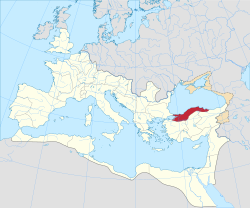Chalcedon
Chalcedon
Χαλκηδών | |
|---|---|
Town | |
 The small Church of St Euphemia that serves as the Greek Orthodox cathedral of the Metropolitan Diocese | |
| Etymology: Carthage | |
 Bithynia as a province of the Roman Empire, 120 AD | |
| Coordinates: 40°59′04″N 29°01′38″E / 40.98444°N 29.02722°E | |
| Country | Bithynia |
Chalcedon (
The site of Chalcedon is located on a small peninsula on the north coast of the
The Greek name of the ancient town is from its Phoenician name qart-ħadaʃt, meaning "New Town", whence Karkhēd(ōn),[3] as similarly is the name of Carthage. The mineral chalcedony is named after the city.[4]
Prehistory
The mound of
Pliny states that Chalcedon was first named Procerastis, a name which may be derived from a point of land near it: then it was named Colpusa, from the harbour probably; and finally Caecorum Oppidum, or the town of the blind.[5]
Megarian colony
Chalcedon originated as a
Nevertheless, trade thrived in Chalcedon; the town flourished and built many temples, including one to Apollo, which had an oracle. Chalcedonia, the territory dependent upon Chalcedon,[9] stretched up the Anatolian shore of the Bosphorus at least as far as the temple of Zeus Urius, now the site of Yoros Castle, and may have included the north shore of the Bay of Astacus which extends towards Nicomedia. Important villages in Chalcedonia included Chrysopolis[10] (the modern Üsküdar) and Panteicheion (Pendik). Strabo notes that "a little above the sea" in Chalcedonia lies "the fountain Azaritia, which contains small crocodiles".[11]
In its early history Chalcedon shared the fortunes of Byzantium. Later, the 6th-century BC Persian
Roman city
The city was partly destroyed by
During the Empire, Chalcedon recovered, and was given the status of a free city. It fell under the repeated attacks of the barbarian hordes who crossed over after having ravaged Byzantium, including some referred to as Scythians who attacked during the reign of Valerian and Gallienus in the mid 3rd century.[13]
Byzantine and Ottoman suburbs
Chalcedon suffered somewhat from its proximity to the new imperial capital at Constantinople. First the Byzantines and later the Ottoman Turks used it as a quarry for building materials for Constantinople's monumental structures.[14] Chalcedon also fell repeatedly to armies attacking Constantinople from the east.
In 361 AD it was the location of the
In 451 AD an ecumenical council of Christian leaders convened here. See below for this Council of Chalcedon.
The general Belisarius probably spent his years of retirement on his estate of Rufinianae in Chalcedonia.
Beginning in 616 and for at least a decade thereafter, Chalcedon furnished an encampment to the
Chalcedon was badly damaged during the
Ecclesiastical history
Chalcedon was an episcopal see at an early date and several Christian martyrs are associated with Chalcedon:
- The virgin St. Euphemia and her companions in the early 4th century; the cathedral of Chalcedon was consecrated to her.
- St. Sabel the Persian and his companions.
It was the site of various ecclesiastical councils. The Fourth
After the council, Chalcedon became a
- St. Adrian, a martyr;
- St. John, Sts. Cosmas and Nicetas, during the Iconoclastic period;
- Maris, the Arian;
- Heraclianus, who wrote against the Monophysites;
- Leo, persecuted by Alexius I Comnenus.
Greek and Catholic successions
The Greek Orthodox Metropolitan of Chalcedon holds senior rank (currently third position) within the Greek Orthodox patriarchal synod of Constantinople. The incumbent is Metropolitan Athanasios Papas. The cathedral is that of St. Euphemia.
After the
Chalcedon has also been a
- Syrian (Antiochian Rite, established in 1922; vacant since 1958)
- Armenian Catholic (Armenian Rite, established 1951, after two incumbents, suppressed in 1956)
Notable people
- Euphemia (3rd century AD), Christian saint and martyr, patron saint of Chalcedon
- Boethus (2nd century BC), Greek sculptor
- Herophilos (2nd century BC), Greek physician
- Phaleas of Chalcedon (4th century BC), Greek statesman
- Thrasymachus (5th century BC), Greek sophist
- Xenocrates (4th century BC), Greek philosopher
See also
- List of ancient Greek cities
- List of traditional Greek place names
- Chalkidona, Greece
References
- ^ "Chalcedon". Dictionary.com Unabridged (Online). n.d. Retrieved 2008-09-21.
- ^ William Smith, LLD, ed. (1854). Dictionary of Greek and Roman Geography. "Chalcedon".
- ^ Harper, Douglas. "Chalcedony". Online Etymology Dictionary. Retrieved 2010-05-19.
- Walter de Gruyter) 2007, S. 307 (online)
- ^ Pliny. Nat. 5.43
- ^ Herodotus. Histories. 4.144.
- ^ Strabo (p. 320).
- ^ Pliny. Nat. 9.15
- ^ Herodotus. Histories. 4.85.)
- ^ Xenophon, Xen. Anab. 6.6, 38-Z1.
- ^ Strabo 1.597.
- ^ Appian. Mithrid. 71; Plut. Luc. 8.
- ^ Zosimus 1.34.
- ^ Ammian. 31.1, and the notes of Valesius.
- ^ Gibbon. Decline, &c. 100.46.
- ^ Michel Le Quien, Oriens christianus, I, 599.
- ^ In Anatolikos Aster XXX, 108.
- ^ In Échos d'Orient III, 85, 204; IV, 21, 104.
- ^ Sophrone Pétridès, "Chalcedon" in Catholic Encyclopedia (New York 1908)
- ISBN 978-88-209-9070-1), p. 855
- ^ Chalcedon (Titular See)
 This article incorporates text from a publication now in the public domain: Smith, William, ed. (1854–1857). "Chalcedon". Dictionary of Greek and Roman Geography. London: John Murray.
This article incorporates text from a publication now in the public domain: Smith, William, ed. (1854–1857). "Chalcedon". Dictionary of Greek and Roman Geography. London: John Murray.

